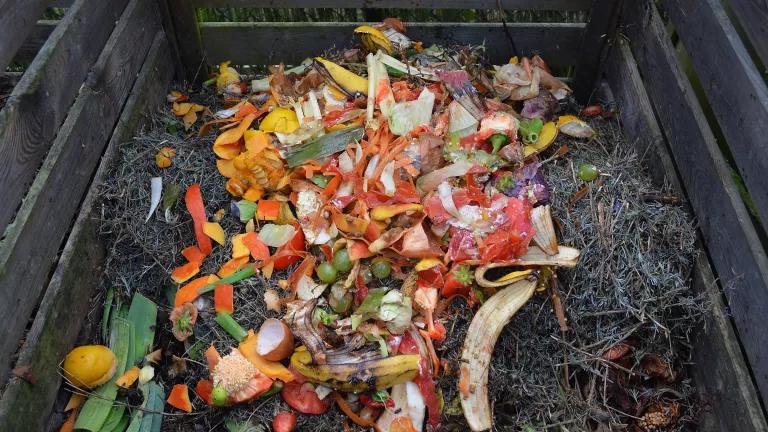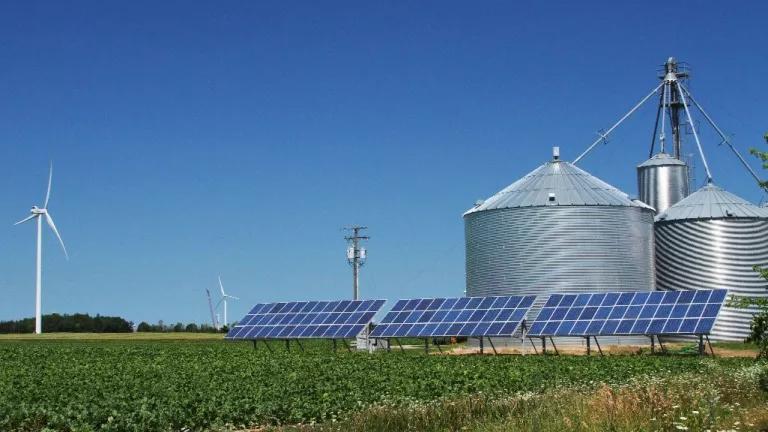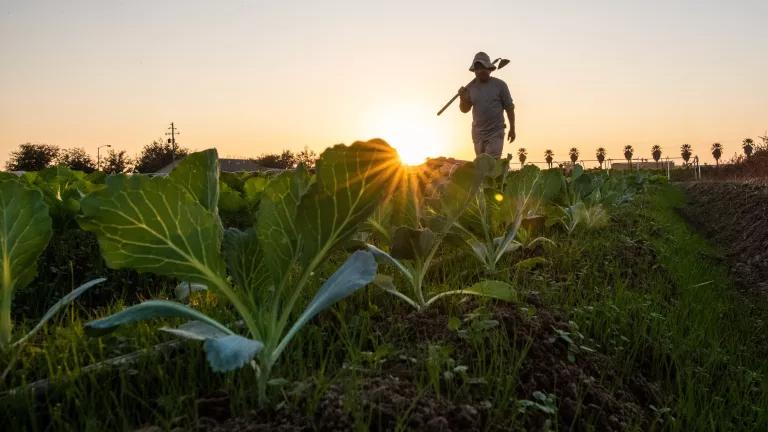
Vue Her is a Hmong farmer who grows Asian specialty crops near Fresno, CA.
Our food system is in peril, with increasing instability in agriculture from climate change, widespread food insecurity, and continued reliance on chemicals that threaten health and the environment. It is time to shift more attention—and resources—to time-tested, proven solutions. Organic agriculture is an ideal starting point.
NRDC’s new report, Grow Organic: The Climate, Health, and Economic Case for Expanding Organic Agriculture, published in partnership with the Swette Center for Sustainable Food Systems at Arizona State University and Californians for Pesticide Reform, distills the latest scientific research on the wide-reaching benefits of organic farming systems, and offers insights from more than a dozen organic farmers and ranchers around the country working at every scale of organic. It also explains the pitfalls of our current agricultural system and provides concrete policy recommendations on how to maximize the benefits of organic.
Our Climate, Health, and Economies Need More Organic Agriculture
Unlike conventional agriculture, which relies on fossil fuel–intensive pesticides and fertilizers that undermine human health and pollute our air, water, and soil, organic agriculture is based on a set of principles and values that center ecological diversity, natural materials, and healthy soil. To be certified “organic,” farmers and ranchers must adhere to a set of scientifically supported practices, rooted in Indigenous knowledge of ecosystems and now defined in federal law, that treat farming and nature as a holistic and interrelated system, both below and above the ground.

Organic Reduces Emissions and Builds Resilience
Organic reduces the greenhouse gas (GHG) footprint of agriculture by avoiding most fossil fuel–based inputs, and it builds climate resilience by promoting healthy soils, diversifying food crops, and supporting threatened wildlife habitats and biodiversity. Data show that organic farms emit less nitrous oxide by avoiding chemical fertilizers and pesticides commonly used in conventional agriculture, and organic livestock production generates fewer methane emissions compared with conventional concentrated animal feeding operations (CAFOs).
By building healthy soil that retains water and stores carbon, organic agriculture also builds resilience and stabilizes our food supply in the face of drought and other extreme weather conditions that will occur with increasing frequency in a changing climate.
Organic Protects and Promotes Health
Organic agriculture dramatically reduces exposure to pesticides, which cause serious acute and chronic health issues for farmworkers and communities near conventional farms. Organic producers also avoid the vast majority of chemicals and other substances that are allowed in or on nonorganic foods, and they limit fertilizer and waste contamination of waterways.
Organic Contributes to Prosperity and Revitalizes Communities
Organic creates economic vitality and growth important to farmers and farming communities. Researchers have identified “organic hotspots” across the United States where increased organic production generates new jobs, lowers unemployment, and spurs agricultural business growth across a region. An emerging generation of young farmers is discovering that organic agriculture can be both productive and profitable, enabling these farmers to stay in business and expand production for local and regional markets.
Organic Needs Federal (and State) Support to Reach its Full Potential
Unfortunately, federal investments in technical assistance, research and marketing have not matched the consistent, rapid growth of the organic sector. For example, in 2021, the U.S. Department of Agriculture (USDA) spent just 2% of its research budget on organic.
A meaningful increase in funding for organic—throughout the Farm Bill and across the federal government—is long overdue, especially as farmers and ranchers are increasingly interested in sustainable practices and resilience in the face of climate change. We need to expand existing programs that support organic farming and ranching, develop new ones, and ensure that organic is for everyone, including producers and communities of color who haven’t been served fairly by federal agricultural policies or our food system. Our report offers detailed policy recommendations to maximize the potential of organic agriculture, including:
Reduce barriers to organic: Producers seeking organic certification must undertake a long, challenging, and financially risky process—typically with little government support. We need more resources that support organic transition, especially for Black, Indigenous, and other people of color (BIPOC). We also need to dedicate an equitable share of research, technical assistance, and other public investments in agriculture to smooth the path toward organic certification.
Advance equity in organic agriculture: BIPOC producers face unique and significant roadblocks within the organic sector, which must be addressed to ensure that the organic sector represents and serves diverse communities. Congress and USDA should prioritize an array of targeted services for underinvested geographic regions and communities, including the Southeast, Tribes, and non-English-speaking producers.
Expand markets for and increase access to organic: The federal government can help grow markets for organic food and increase healthy food access by leveraging its own purchasing power. Organic should be prioritized in all government food programs and buying guidance for agencies.
Account for “true costs” in policymaking: Current processes for assessing the benefits and burdens of our public investments tend to value private economic benefits for businesses over public costs of environmental, health, and social harms—if those costs are even considered. USDA should instead analyze the full suite of costs and benefits of policies to better align public investments with public benefits.
After 20 years of federally regulated organic production, with minimal public policy support and funding, the organic sector has already exceeded expectations, growing at a rate that far outpaces that of heavily subsidized conventional production. Establishing organic as a national priority is an essential investment in our future.





